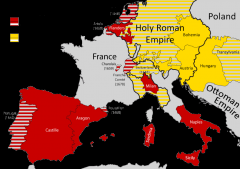![]()
![]()
![]()
Use LEFT and RIGHT arrow keys to navigate between flashcards;
Use UP and DOWN arrow keys to flip the card;
H to show hint;
A reads text to speech;
14 Cards in this Set
- Front
- Back
|
Allegory; personification; attribute |
a story, poem, or picture that can be interpreted to reveal a hidden meaning, typically a moral or political one --> allegorical personifications of America, Asia, and Africa presenting national goods to Charles V in allegorical painting Abdication of Charles V; allegorical representation of Spring in Primavera |
|
|
allegorical maps |
depictions of landscapes in a distorted shape in order to create a political or artistic: England in shape of queen, Netherlands in shape of lion, etc. |
|
|
cross-cultural fertilization |
transmission of culture and exchange of ideas among intellectuals and craftsmen; was not a conscious political movement |
|
|
Urban |
Hungarian engineer who invented the canon and sold it to the Ottoman Empire when the Byzantine emperor could not afford it; invention was used to help the Ottomans seize Constantinople |
|
|
Constantinople (Istanbul) |
sat at point of intersection between Christian controlled North and Muslim controlled South and was an important port of trade and city of intellectual riches fell to the Ottomans in 1453 when seized from Christians named for Roman emperor Constantine who converted people to Christianity |
|
|
Fall of Constantinople |
May 28, 1453 Christian held Constantinople fell to the Muslim Ottoman empire There was very little intervention in the siege, one part because the cannon was new tech and also because there was no concern trade would not continue Christian churches were converted to mosques and new mosques were modeled after Christian churches in the city |
|
|
Medici Family |
bankers to the Pope; Cosimo, Lorenzo, Ferdinando, Francesco --> powerful Florentine family who traded in luxury goods from around the known world; encouraged the cultural cultivation of Florence |
|
|
Constantine XI Palaiologos |
last reigning Byzantine emperor; died during fall of Constantinople and hi death marked the end of the Roman empire |
|
|
Christendom |
The term usually refers to the medieval and early modern period, during which the Christian world represented a geopolitical power juxtaposed with both the pagan and especially the Muslim world; |
|
|
birds of paradise |
rare and expensive item from the Americas that was circulated among high noble families in Europe and used a representation of the Americas in paintings; shows ignorance of Americas for scholars removed from the land in that they assumed B of P had no feet |
|
|
diplomatic exchange |
exchange of goods from newly discovered lands among noble families; power relations were related to the distribution of goods; bird of paradise was given as gift among rulers |
|
|
1438 Florentine Council |
Medici facilitated the reconciliation between the Catholic and the Byzantine churches in which the church promised to protect the Byzantine empire from the Ottomans; didn't happen (Byzantine Emperor JohnVIII, Patriarch Joseph II, Lorenzo de’ Medici) |
|
|
Habsburg empire |

The various Habsburg possessions never really formed a single country—each province was governed according to its own particular customs <--photo of empire in 1700 |
|
|
Charles V |
Holy Roman Emperor ruler of both the Spanish Empire from 1516 and the Holy Roman Empire from 1519, as well as of Habsburg Netherlands from 1506 |

